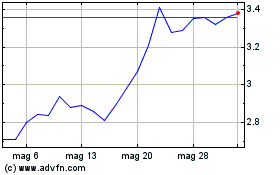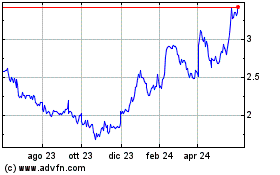Arbutus Biopharma Corporation (Nasdaq: ABUS) (“Arbutus” or the
“Company”), a clinical-stage biopharmaceutical company leveraging
its extensive virology expertise to develop a functional cure for
people with chronic hepatitis B virus (cHBV) infection, announced
new preliminary end-of-treatment (EOT) data from the Phase 2a
clinical trial (IM-PROVE II, AB-729-202) in patients receiving
ongoing standard-of-care nucleos(t)ide analogue (NA) therapy
indicating that treatment with imdusiran, Arbutus’ RNAi
therapeutic, followed by Barinthus Biotherapeutic's T-cell
stimulating immunotherapeutic, VTP-300, was generally safe,
well-tolerated and led to maintenance of lower HBsAg levels during
the post-treatment follow-up period in patients with cHBV. The data
were presented today by Dr. Kosh Agarwal, MD, Consultant
Hepatologist and Transplant Physician at the Institute of Liver
Studies at King’s College Hospital, London, during a session
focused on new treatments for viral hepatitis B at the European
Association for the Study of the Liver (EASL) Congress.
Dr. Agarwal presented the following data from 38
of 40 patients that were on stable NA therapy throughout the
treatment period, received imdusiran (60mg every 8 weeks) for 24
weeks and were then randomized to receive either VTP-300 (treatment
arm) or placebo at Weeks 26 and 30:
- Robust reductions of HBsAg were
seen during the imdusiran lead-in period (-1.8 log10 by week 26)
with 95% of patients achieving HBsAg <100 IU/mL before
undergoing dosing in the treatment or placebo arm.
- At 24-weeks post-EOT, there was a
significant difference (p<0.05) in HBsAg levels between the
treatment arm (n=5) and placebo (n=6).
- 94% of patients (n=18/19) in the
treatment arm achieved HBsAg levels of <100 IU/mL and 36%
(n=7/19) had <10 IU/mL at EOT (Week 48) compared to 84%
(n=16/19) and 21% (n=4/19), respectively in the placebo arm.
- Similarly, at 24-weeks post-EOT
(Week 72), the treatment arm had lower HBsAg levels with 80% of
patients (n= 4/5) at <100 IU/mL and 60% (n=3/5) at <10 IU/mL
compared to the placebo arm with 16% (n=1/6) and 0% (n=0/6),
respectively.
- 84% of patients (n=16/19) in the
treatment arm met the NA therapy discontinuation criteria and
stopped NA treatment after Week 48 compared to 53% (n=10/19) in the
placebo arm. One patient in the treatment arm achieved undetectable
HBsAg and another had a >1.5 log10 decline between the last two
visits during the NA-therapy discontinuation follow-up period.
- Treatment with imdusiran and
VTP-300 was generally safe and well-tolerated. There were no
Serious Adverse Events (SAEs), Grade 3 or 4 Adverse Events (AEs) or
discontinuations due to treatment. The most common
treatment-related AEs in two or more patients were injection
site-related (both imdusiran and VTP-300) and transient ALT
increases (imdusiran).
Dr. Agarwal commented, “These data show that
adding imdusiran and VTP-300 to ongoing NA therapy in cHBV patients
meaningfully reduces HBsAg after the end of the treatment period. I
am impressed with the number of patients that qualified to stop NA
therapy in the VTP-300 group and the clear separation in HBsAg
levels between the treatment arm and placebo at Week 72.”
“Imdusiran consistently provides notable
reductions in HBsAg prior to combining with other therapies, such
as VTP-300, which may improve the response rates of these
immunomodulatory approaches,” commented Dr. Karen Sims, Chief
Medical Officer of Arbutus Biopharma. “We continue to believe that
lowering surface antigen is key to promoting HBV-specific immune
reawakening. We are looking forward to the data coming in the
second half of this year from the additional arm of this trial
evaluating the potential of nivolumab, a PD-1 monoclonal antibody,
to further enhance responses to this treatment regimen.”
The slides from the oral presentation at EASL
2024 can be accessed through the Arbutus website under
Publications.
IM-PROVE II Trial Details
The IM-PROVE II Phase 2a clinical trial
initially enrolled 40 non-cirrhotic, virally suppressed cHBV
patients that were on stable NA therapy. The patients initially
received imdusiran (60mg every 8 weeks) for 24 weeks with on-going
NA therapy and were then randomized to receive either VTP-300 or
placebo at Weeks 26 and 30 (and conditionally at Week 38 if they
experienced a >0.5 log10 decline in HBsAg between Weeks 26 and
34). After completion of the treatment period at Week 48, those
patients who met the following criteria: ALT levels less than two
times the upper level of normal, HBV DNA less than the lower limit
of quantitation, HBsAg <100 IU/mL, and HBeAg negative,
discontinued NA therapy and were followed for an additional 48
weeks. Those who did not meet the criteria continued on NA therapy
for an additional 24 weeks of follow-up.
This trial has been amended to include an
additional cohort of 20 patients that will receive imdusiran plus
NA therapy for 24 weeks followed by VTP-300 plus up to two low
doses of nivolumab, an approved PD-1 monoclonal antibody.
Enrollment is complete in this additional cohort with preliminary
data expected in the second half of 2024.
About Imdusiran (AB-729)
Imdusiran is an RNA interference (RNAi)
therapeutic specifically designed to reduce all HBV viral proteins
and antigens including hepatitis B surface antigen, which is
thought to be a key prerequisite to enable reawakening of a
patient’s immune system to respond to the virus. Imdusiran targets
hepatocytes using Arbutus’ novel covalently conjugated
N-Acetylgalactosamine (GalNAc) delivery technology enabling
subcutaneous delivery. Clinical data generated thus far has shown
single and multiple doses of imdusiran to be generally safe and
well-tolerated, while also providing meaningful reductions in
hepatitis B surface antigen and hepatitis B DNA. Imdusiran is
currently in multiple Phase 2a clinical trials.
About HBV
Hepatitis B is a potentially life-threatening
liver infection caused by the hepatitis B virus (HBV). HBV can
cause chronic infection which leads to a higher risk of death from
cirrhosis and liver cancer. Chronic HBV infection represents a
significant unmet medical need. The World Health Organization
estimates that over 250 million people worldwide suffer from
chronic HBV infection, while other estimates indicate that
approximately 2.4 million people in the United States suffer from
chronic HBV infection. Approximately 820,000 people die every year
from complications related to chronic HBV infection despite the
availability of effective vaccines and current treatment
options.
About Arbutus
Arbutus Biopharma Corporation (Nasdaq: ABUS) is
a clinical-stage biopharmaceutical company leveraging its extensive
virology expertise to identify and develop novel therapeutics with
distinct mechanisms of action, which can be combined to provide a
functional cure for patients with chronic hepatitis B virus (cHBV).
We believe the key to success in developing a functional cure
involves suppressing HBV DNA, reducing surface antigen, and
boosting HBV-specific immune responses. Our pipeline of internally
developed, proprietary compounds includes an RNAi therapeutic,
imdusiran (AB-729), and an oral PD-L1 inhibitor, AB-101. Imdusiran
has generated meaningful clinical data demonstrating an impact on
both surface antigen reduction and reawakening of the HBV-specific
immune response. Imdusiran is currently in three Phase 2a
combination clinical trials. AB-101 is currently being evaluated in
a Phase 1a/1b clinical trial. For more information, visit
www.arbutusbio.com.
Forward-Looking Statements and
Information
This press release contains forward-looking
statements within the meaning of the Section 27A of the Securities
Act of 1933 and Section 21E of the Securities Exchange Act of 1934,
and forward-looking information within the meaning of Canadian
securities laws (collectively, forward-looking statements).
Forward-looking statements in this press release include statements
about the potential to lead to a functional cure for HBV, our
future development plans for our product candidates; the expected
results of our clinical development plans and clinical trials with
respect to our product candidates; our expectations with respect to
the release of data from our clinical trials and the expected
timing thereof; and the potential for our product candidates to
achieve success in clinical trials.
With respect to the forward-looking statements
contained in this press release, Arbutus has made numerous
assumptions regarding, among other things: the effectiveness and
timeliness of preclinical studies and clinical trials, and the
usefulness of the data; the timeliness of regulatory approvals; the
continued demand for Arbutus’ assets; and the stability of economic
and market conditions. While Arbutus considers these assumptions to
be reasonable, these assumptions are inherently subject to
significant business, economic, competitive, market and social
uncertainties and contingencies.
Additionally, there are known and unknown risk
factors which could cause Arbutus’ actual results, performance or
achievements to be materially different from any future results,
performance or achievements expressed or implied by the
forward-looking statements contained herein. Known risk factors
include, among others: anticipated pre-clinical studies and
clinical trials may be more costly or take longer to complete than
anticipated, and may never be initiated or completed, or may not
generate results that warrant future development of the tested
product candidate; Arbutus may elect to change its strategy
regarding its product candidates and clinical development
activities; Arbutus may not receive the necessary regulatory
approvals for the clinical development of Arbutus’ products;
economic and market conditions may worsen; market shifts may
require a change in strategic focus.
A more complete discussion of the risks and
uncertainties facing Arbutus appears in Arbutus’ Annual Report on
Form 10-K, Arbutus’ Quarterly Reports on Form 10-Q and Arbutus’
continuous and periodic disclosure filings, which are available at
www.sedar.com and at www.sec.gov. All forward-looking statements
herein are qualified in their entirety by this cautionary
statement, and Arbutus disclaims any obligation to revise or update
any such forward-looking statements or to publicly announce the
result of any revisions to any of the forward-looking statements
contained herein to reflect future results, events or developments,
except as required by law.
Contact
Information Investors and
Media
Lisa M. Caperelli Vice President, Investor
Relations Phone: 215-206-1822 Email:
lcaperelli@arbutusbio.com
Grafico Azioni Arbutus Biopharma (NASDAQ:ABUS)
Storico
Da Dic 2024 a Gen 2025

Grafico Azioni Arbutus Biopharma (NASDAQ:ABUS)
Storico
Da Gen 2024 a Gen 2025
